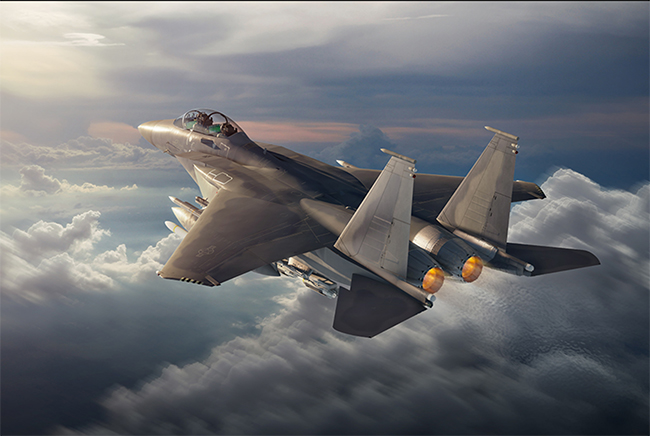
An artist illustration of the F-15EX. Boeing photo.
Boeing’s vice president for advanced F-15 programs, Prat Kumar, said the company is encouraged by the House Appropriations defense subcommittee’s version of the fiscal 2020 funding bill, which provides initial funding for the F-15EX. However, he also noted it’s “just the first step in a long process.”
The legislation, which will be marked up by the subcommittee on May 15, validates Air Force strategy for supplementing the fighter force, he said. Kumar acknowledged that in last week’s House Armed Services Committee tactical aviation hearing, there was skepticism voiced by members about USAF’s request to supplement its fighter fleet with new-build F-15EXs, but said that Rep. Donald Norcross (D-N.J.), chairman of the House Armed Services Committee’s Subcommittee on Tactical Air and Land Forces, and Rep. Vicky Hartzler (R-Mo.), the subcommittee’s ranking member, have visited Boeing and “had a chance to see what the F-15EX has to offer.” That visit took place before the hearing, Kumar said.
In a briefing for reporters at Boeing’s St. Louis, Mo., fighter and trainer production facilities, Kumar said the Air Force hasn’t decided whether it will buy two-seat F-15EXs or a single-seat version, called F-15CX. If the service wants single-seat jets, Boeing can accommodate it, he asserted. The Air Force has previously said it would fly the two-seat EX with just a pilot and no backseater.
The Air Force campaign is the latest in a years-long effort to keep the F-15 line running, Kumar said, asserting that discussions about new purchases of the Eagle by the Air Force started in earnest “a couple of years go” and “really picked up steam last year.” Those discussions took place with Air Combat Command and the F-15 system program office, on “what is the art of the possible,” he said.
If the Air Force wants to get new F-15s quickly for test, both the order and delivery of the first two jets could happen in 2020, Kumar said, adding it will depend on the request for proposals.
The production line is now configured for 12 aircraft a year, but Kumar said Boeing had been holding production low in order to buy time to find new orders and it can be increased to 36 a year without difficulty. In fact, he acknowledged that Boeing has bought long-lead items supporting a potential initial USAF buy.
“We could do two next year and six in ’21,” he said.
Qatar has ordered 36 F-15s, but is approved for 72. The Air Force’s future years’ defense plan calls for 80 updated F-15s, and Kumar said there is “renewed interest” from countries that already operate the fighter, such as Israel, which is considering another 20-25 aircraft. He declined to identify other potential customers, but Japan, South Korea, and Singapore operate the F-15. The Saudi Arabian order for F-15SAs will conclude this year, when production will shift to the Kuwait buy. All in all, there is “no danger” of the line shutting down for lack of interest, he said, indicating that the Air Force buy is not crucial to continued F-15 production.
The Saudi/Qatari version of the F-15, with new processors, new radar, new cockpit displays, and a digital flight control system, wrapped five years of testing four months ago, Kumar said. The F-15EX would be largely the same, but with the EPAWSS electronic warfare/threat detection system, which is still in test. The Air Force would install the GE F110-129 engine, and they would be government-furnished equipment, Kumar reported.
Boeing furnished travel and accommodations for reporters covering the event.